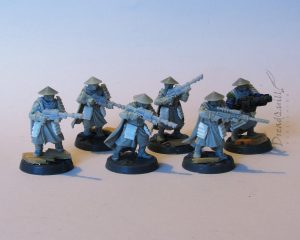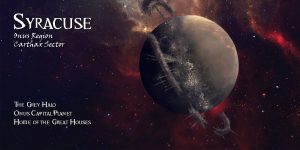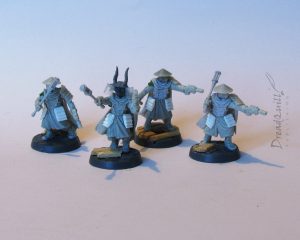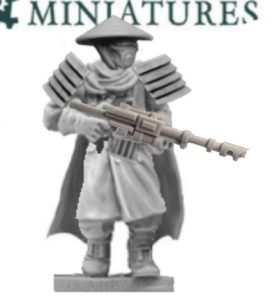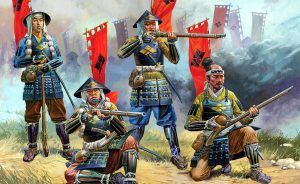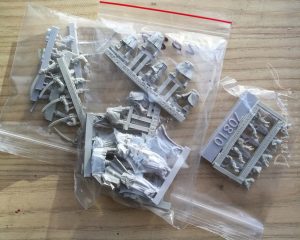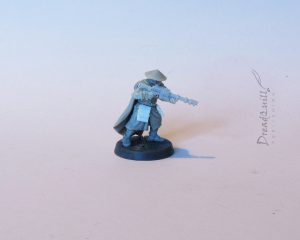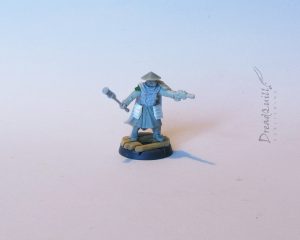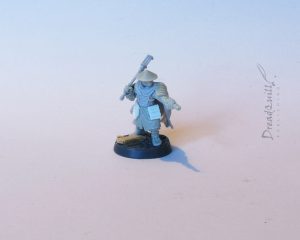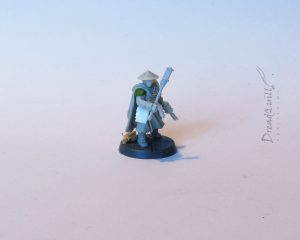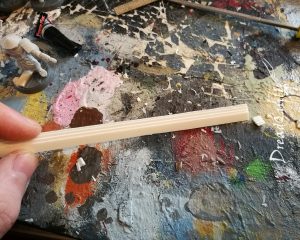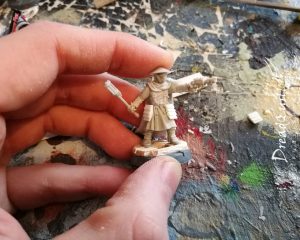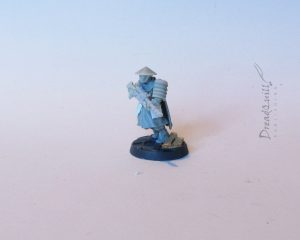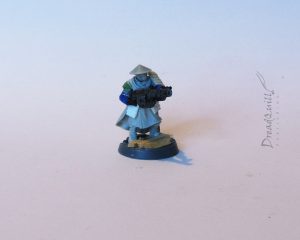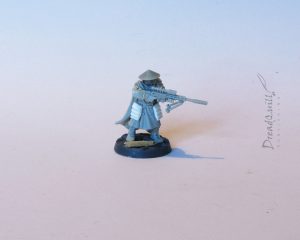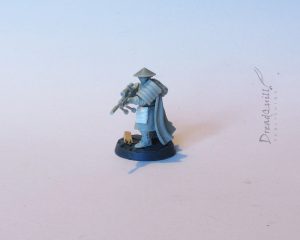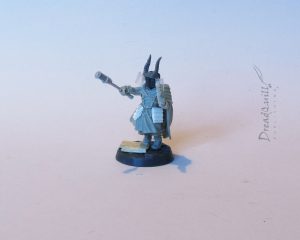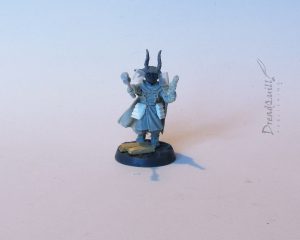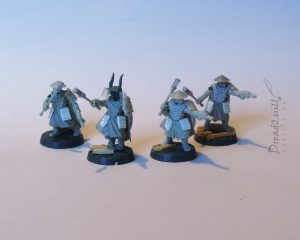The planet of Syracuse is the biggest, most sprawling planet our plucky Dark Heresy acolytes will have been to so far in their illustrious crime-fighting careers. It is here they will finally meet their Inquisitor (after 4+ years of real life campaigning) and mingle with other acolytes of the Onus Region Conclave. They will receive their orders, be given a direction and then sent off to the arse end of the planet, Syracuse Magna, to pursue a lead on the potentially apocalyptic Samarra Dynasty.
We’ve already seen one of the factions of Syracuse magna, an organised crime syndicate called The Undertow, and now we’re having a look at their lawful (if not moral) counterparts, the Ash Garrison Enforcers.
Ash Garrison Enforcers
On the rest of Syracuse, the Ashigaru PDF, or Ash Garrison, comprise of mercenaries and family members of the Great Houses, refining their martial skills with polearm and lasgun to serve in the largest standing army in the Onus Region. The Ash Garrison are called upon as loyal foot soldiers to tackle uprisings, gang warfare or noble squabbles, and some are shipped off to deal with far away threats where their combined arms tactics of rifle and spear makes for a formidable threat against any foe.
They are intended to support the local laws of Syracuse Magna, maintain order and deal with such common crimes as murder, smuggling and extortion, while the Adeptus Arbites (in theory) deal with crimes directed against the Adepta, such as petty heresy, slaving and corruption that contravene high Imperial Law.
In Syracuse Magna, the Provincial Enforcers are divided, corrupt and unsubtle agents of punishment and social control, and most are little more than state-sponsored extortionists. Their power is granted by the Daimyo and the Quorum, and by extension, they are sanctioned by Magna’s dissolute and corrupt nobility. At their core are the Mandato, a feared secret police force of torturers and killers that exist purely to maintain the Daimyo’s power.
Clad in vulcanized storm coats and conical helmets to deter the worst of the weather, the Ash Garrison are well-equipped and brutal in approach. They operate in 4-man teams, either ‘Disciplinaries’ with stun sticks and laspistols or ‘Remedials’ with lasguns. Remedial teams can be accompanied by either a grenade launcher or hunting rifle.
Creating the Ash Garrison
The concept art folder and mood boards I had assembled for Syracuse are extensive, and in my travels I stumbled across this rather excellent piece by Keith Thompson and knew I wanted to recreate that flavour in my own foot soldiers.
Doing some digging around, I found these rather excellent heads and shoulder pads from Puppets War that I tacked onto another order, with little thought as to how I was going to assemble them later. Like a big dumb idiot I didn’t order enough shoulder pads either, so although the intention was for big samurai-style shoulder pads on each style, I didn’t read that “x10 shoulder pads” meant literally that, and not “enough shoulder pads for x10 models”. So, lopsided shoulder pads were going to have to happen.
One of my real life comrades was putting an order into Victoria Miniatures and I figured that was a great opportunity to bang the last nail into the coffin of this project, and had a quick browse through their wares. After taking a few quick screenshots, I bashed together this image to give me an idea of what my Enforcers were going to look like.
I wasn’t entirely sure how I was going to get the shoulder pads to work with the moulded capes, but that was a problem that Future Me would deal with. I’m a big fan of the Shogun: Total War games, and have always had a soft spot for the Matchlock Ashigaru units for their aesthetics, so I was going to try and capture that as best I could.
I was 99% convinced I was going with back banners as well, then remembered my utter contempt for painting freehand back banners, and justified it by saying that the Magna Enforcers weren’t as fancy as their upmarket noble brethren in the posher provinces, so wouldn’t have back banners.
And then the parts arrived! I had to be strong-willed to not dig in to these as soon as they arrived, as I had a bunch of work I needed to do for Mother of Mercy. With that out the way and some suitable recovery time later, we’re back in the action and assembling cool models.
For their bases, I wanted something a little less dingy than the Undertow, but still equally run down. I opted for a pack of the rather splendid Sector Imperialis bases from Games Workshop, justifying it that I could use the 40mm bases for Inquisitor as well. With the addition of some broken lollipop sticks for wood, and some water effects after they’d been painted, I was hoping to go for a run down manufactorum or derelict fish factory look.
Assembling the masses
Putting the majority of the Ash Garrison together was surprisingly simple. The Victoria parts, as disparate as they were considering I ordered the most awkward combination, went together rather pleasingly. I made a note to pin them through their toes to their bases, as as bouncy as resin is, I didn’t have much faith in my superglue keeping them attached.
The arms and guns slotted together quite nicely, although in once instance I wasn’t entirely sure how the pose of a pair of arms was intended, as it never seemed to match up to the weapon or body whatever I tried. Cue hacking, filing and putty-work and it didn’t matter – it bends to my will.
Initially none of the models had shoulder pads or thigh guards. I knew this was on the cards, but I didn’t want to start carving parts of my minis away until I had put together the whole team and figured out how I was going to approach this. As I was building them, I knew I wanted to have a range of weapons (similar to the Undertow) for different circumstances and challenge levels, and that was how the idea of different fighting teams came about.
The Disciplinaries were a pain in the butt. As rad cool as the stun sticks from Victoria were, they were extremely bendy and many needed a date with the hair dryer to get them looking less like boomerangs. On top of that, the handles are very thin – not thin enough to be able to remove and replace with a length of brass pole or paperclip, but not thick enough to be able to pin in place. Most had to deal with having a fraction of a millimetre drilled into the hand and base of the shaft and hope I don’t drop them in the future.
And weirdly at this point I began to notice that many of the left arms didn’t have the little extra shoulder pad, it seemed the ‘melee’ arms were missing them, but the rifle arms all had them. I resigned myself to knowing I was going to need to get the putty out again before this project was over.
After assembling all the bodies, I realised I was going to have to figure out a way of attaching the shoulder pads and doing a little extra on the bodies to being the whole aesthetic together. The masochist in me wanted to sculpt an entire armoured skirt over the trench coat legs, but if I had already trimmed the back banner plans from my list, then this “good idea” could also go and sit in the garbage where it belonged. Nope, I needed a more cunning, time-sensitive solution to this plan.
Cue montage. I snipped a bunch of thick plasticard down into strips and stuck them together with plastic glue, taking care to be liberal with the application but leave one side as mar-free as possible. It all needed to be bonded together for when the inevitable hacking and shaping was to take place, but it still needed to be pretty at the front.
Once it had dried it was a fairly simple, if time-consuming, process of slicing off the desired amount of thigh guard and filing the back down into shape so it would fit against the model snugly.
Although it took a bit of time to prepare each thigh guard, I was happy that the time was well spent, as it allowed me to maintain a consistent look across all the models without hours spent prodding and poking. It was also nice to not have to be concerned about the time-sensitive drying process of modelling putty, which is always a turn-off for me as I know if I have to put the project down (for such weaknesses as human food or waste expulsion) I might come back to a hardened putty and have to restart the process from scratch.
I was happy with the thigh guards – they helped draw the aesthetics together of weird future trench soldier and feudal Japanese plate armour. I wasn’t overly sold on the theme until I started to see several of them together, and along with the cute pointy hats from Puppets War I was really starting to enjoy how they were coming along.
Another issue present was the shoulder pad conundrum. It turned out it wasn’t much of a conundrum, I just didn’t want to address the obvious solution – cutting and filing down parts of the cloak to allow the shoulder pads to fit on the arm more snugly.
Some went on better than others and some needed more encouragement. They all went on eventually, and I think it works as a blend of 40k and ancient east asian aesthetics. I was beginning to feel thankful for my shoulder pad ordering blunder at this point, as I was enjoying the single pad far more than when I draft-built some with both shoulder pads. It gave the models more freedom for poses, and gave it this wonderful lopsided asymmetric look that 40k is infamous for.
After assembling two thirds of the squad as stun stickers and lasgunners, I knew I needed a bit of variety and specialisation in there. Something to change up the game when they entered the field – some support weapons and an officer class.
The first (an easiest) was a trusty grenade launcher from the plastic Cadians kit. I’m not sure a project goes by where a grenade launcher isn’t added to a group of gangers, house guard or police force, they’re just so pleasingly versatile in the game. From a game balance perspective, these guys would only start turning up later in the escalation of violence. Initially all the Ash Garrison would be armed with flashbangs and smoke grenades, but as the riots step up, they’ll start issuing choke and frag grenades along with the launchers to help break up crowds.
The next specialist was a tricky one to decide on. I liked the idea of a suppressive weapon (like the heavy stubber of the Undertow) but decided against it as it would cheapen them when they did arrive. Flamers were out as well, as that was covered by the Undertow, so I had a dig about in my bits box and found a cool sniper rifle, again from Victoria but something from a previous order. I liked the image of the run-down rain-slick streets of Syracuse Magna being watched over by eagle-eyed snipers from different factions, daring the other to make the first move.
Part of me wanted to do something different with this guy, perhaps add some more camouflage, strip back their armour, make them appear more like light infantry. I decided against it in the end, partly because a) I was feeling hecka lazy and b) I wanted the models to be representatives of character the players would fight on the tabletop.
These were supposed to be specialists attached to riot squads rather than the pissing-in-bottles snipers that would haunt the doglegs and alleyways of Magna. They wouldn’t need models because, in my head, you would never get close enough to fight them on a battlemap. Those kinds of combats would be handled narratively, with just an indication of where the snipers were. I needed models to represent close-up brawls and add an element of visual wonder to our games.
The final model that needed to be assembled was some kind of leader. I had already established the Mandato, a secret police of torturers and assassins, but had no intentions to have models for them. After all, they wouldn’t be very secret if they had a battlefield presence would they?
I was struck with the overwhelming to try and convert a proper Oni/Samurai helmet. The Ashigaru conical helmets were fine for the footsloggers, but I wanted something impressive for the leader. I initially started looking for a daemonic/chaos head that could become a mask, but found the horns from a beastman and the head from a Tempestus Scion far quicker.
With a little bit of tubular plastic snipped from the end of a paint brush protector, the Mandato field officer had his helmet. While he stood, he would confer bonuses to his minions to help them avoid pinning, so he’s one to try and take out early into a brawl.
Wrap up and painting
I was dead chuffed with how they all came out in the end. From a piece of concept art and a very shaky photoshop mashup that I wasn’t convinced would work, to a bunch of converted minis that I like so much I’m looking for excuses to make more of them in the new year.
I’ve covered a bunch of different elements, giving them a variety of tools to help even the odds in battle, and injected some character into the different kinds of squads.
As for painting, I’m going to be leaning heavily on some Shogun Total War Ashigaru colour schemes, picking out a few that look good in green and beige. I have some Silver Tower minis to polish off first, but with the whole squad currently undercoated and drying as we speak, it won’t be long before we see some painted minis on the Dreadquill news feeds.
